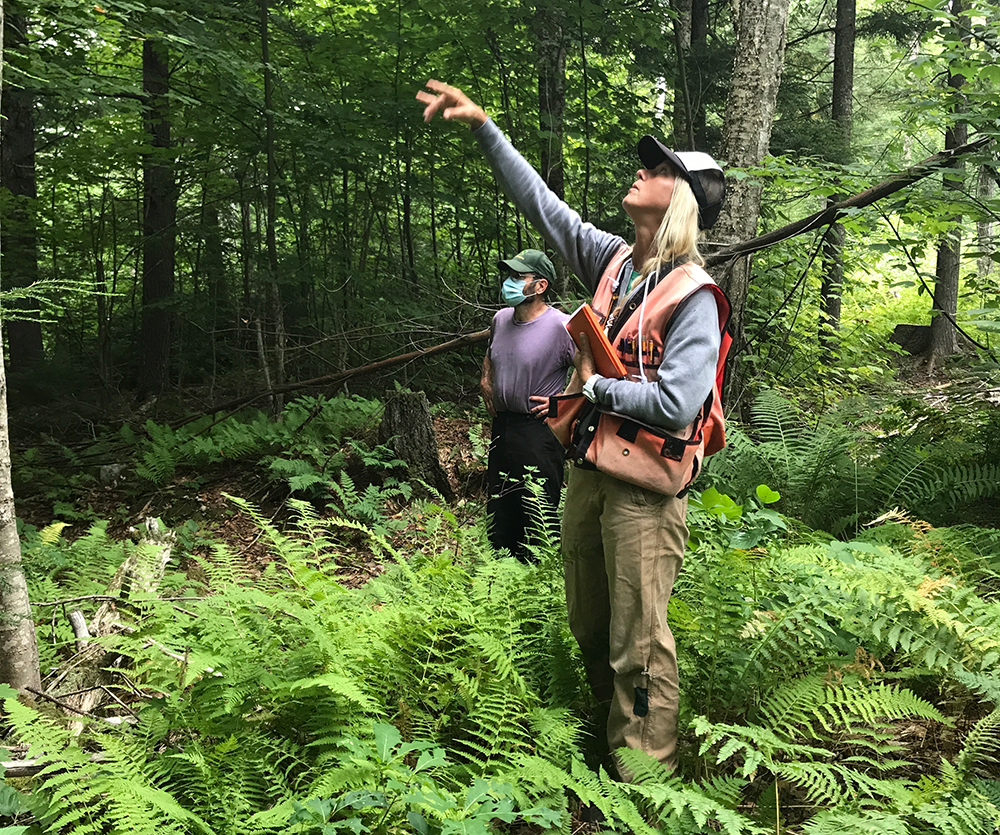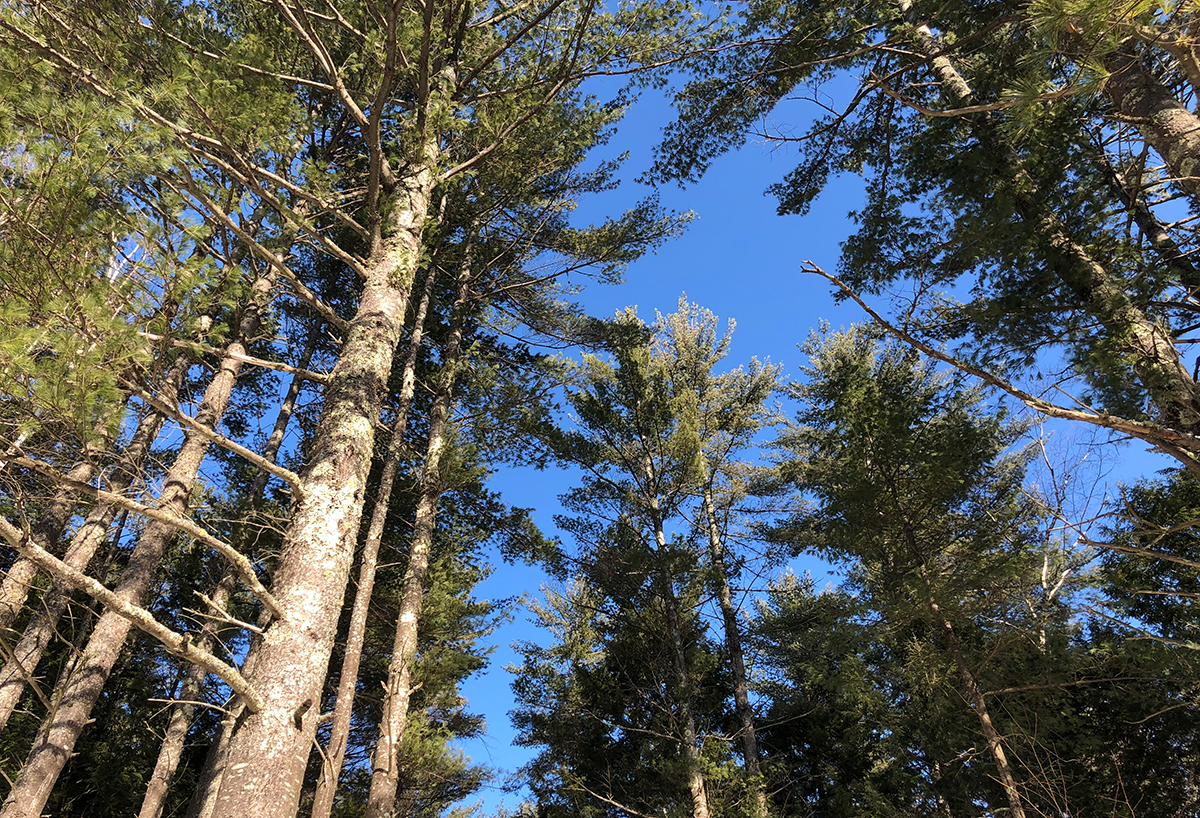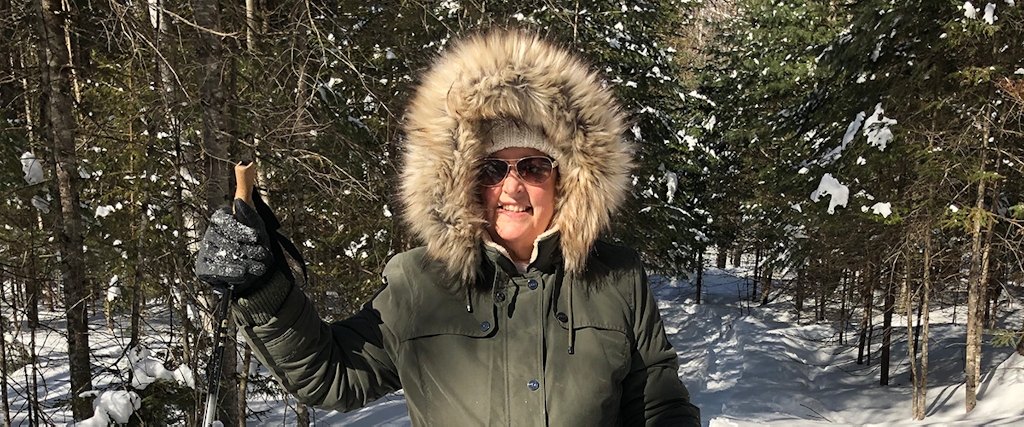NEFF’s Western Maine Habitat Restoration initiative is seeing success in its landowner outreach efforts
In late 2019, a small newspaper ad in the Rumford Falls Times caught the eye of Kim Kavanagh (pictured above) during a break at her job at a local credit union in Western Maine. It showed the face of a furry marten peeking up from the snow and announced an opportunity for woodland owners to receive assistance in improving wildlife habitat through forestry.
“I thought, this looks cool,” Kim said. “It looks like something we could do.” She immediately sent the ad to her husband, Tim Davis.
The couple had moved from Chicago 16 years earlier to help an aging parent and had not looked back. They bought a wooded property in Weld near Mount Blue State Park and made a home. Their discovery of the wildlife on their property was a continual source of joy—and sometimes embarrassment.
“One day early on, I saw this strange animal come out of the woods. It raised up on its haunches and looked at me and I had absolutely no idea what it was,” said Kim. It was a porcupine.
They saw hawks, bear, deer, moose and woodland birds and knew their woods were important to wildlife. They were willing to make their land an even better fit for local wild animals, but didn’t really know how. They took a local forestry course and learned how to identify trees and manage for timber, but still were not clear how to focus on their core value: improving wildlife habitat.
“As transplants from the suburbs we didn’t have a life-long connection to the woods. It was all new,” said Tim. “We thought the best thing to do for wildlife was just leave it alone.”
That started to change when they called in response to the newspaper ad—which highlighted NEFF’s Western Maine Habitat Restoration initiative.
The Western Maine Habitat Restoration Initiative
The initiative’s project area in the Mountains of the Dawn stretches 200 miles from the White Mountains at the New Hampshire border to Baxter State Park in Maine’s north woods. Still almost 98 percent forested, it is home to the biggest remaining block of undeveloped forest left east of the Mississippi and provides critical habitat to a range of species. But as the northeast region faces climate-related problems and becomes more fragmented by development, the Western Maine forest faces local threats too. It is being carved up for recreation lots near lakes and is under increasing pressure to show short-term economic returns on large blocks of industrial forest.
To help build and restore habitat property-by-property across the landscape, the NEFF Western Maine project team works with owners of family woodlots and other non-industrial woodlands to assess the property and develop 10-year habitat restoration plans based on the NEFF Acadian Forest Exemplary Forestry standards. The habitat restoration plans provide the basis for landowners to be considered for reimbursement for recommended forest practices through NEFF’s funding partners, the Natural Resources Conservation Service (NRCS) and the National Fish and Wildlife Foundation. To be eligible to participate, landowners must also make an ethical pledge to embrace long-term Exemplary Forestry stewardship goals for 30 years to ensure that the early investment to create a well-stocked woodland that balances wildlife, climate and timber values yields continuing ecological and timber values in the long term.
Tim Davis spoke to Christine Parrish, the NEFF Western Maine Project Coordinator. This first conversation allowed her to assess landowner and ownership suitability while further introducing the project to Tim. Many conversations followed. In the process, the Davises were introduced to the local NRCS field office staff in Franklin County, who worked with NEFF and the landowners to assist in cost-share under an unrelated program for a forest management plan with a timber inventory—an essential step for coordinating forestry and wildlife habitat improvements.
Moving forward, NEFF’s Western Maine staff will coordinate efforts on the Davis-Kavanagh property with the forester who carries out this forest management plan.
“The real change in understanding about how forestry could work to improve habitat for wildlife is when Carla did a field visit and showed us how removing trees could allow other trees to grow better,” said Tim, referring to NEFF Ecologist Carla Fenner’s on-site discussion of different forest practices, including crop tree release and the value of snags and mast-producing trees. “That was the first time I really had a sense of what trees to cut to help wildlife and what to leave,” said Tim.

NEFF Ecologist Carla Fenner, the technical expert on the Western Maine project,
offers habitat guidance to a landowner. Photo by Christine Parrish
With 14 months of work under her belt, Christine Parrish reports the outreach methods used to identify suitable landowners—like Kim and Tim—and then move them from interest to action are working.
After conducting an initial analysis of the initiative’s demographic, Christine chose outreach methods suitable to a sparsely settled rural region with an older population and deep community identity; a strong hunting, fishing, forestry and outdoor recreation culture; and a population that includes a significant number of non-resident landowners. Methods that resulted in inquiries include newspaper ads, flyers, articles in publications read by target audiences, presentations to town select boards, and presentations to hunting, trapping and snowmobile groups. The landowner assessment process then weeded out candidates who were unlikely to make a 30-year pledge to Exemplary Forestry and focused efforts on those who could. All of this intensive outreach and assessment has paid off, as by fall 2020, 16 landowners representing just under 10,000 acres had applied and were actively engaged in the Western Maine Habitat Restoration initiative.
Tim Davis and Kim Kavanagh have said the reimbursements for the cost of habitat work will allow them to soon implement forest practices that support wildlife, but program benefits beyond financial reimbursement have proven even more important to them: the one-on-one assessment of habitat values on and around their property, the action plan with specific forest practices that will be provided in the NEFF habitat restoration plan, and meeting people, including their new forester and NEFF and NRCS staff.
“We’re excited to know that we are not only learning about what to do but that it won’t stop there,” said Tim. “We will be taking action, too, with good guidance.”
What’s Next? Neighbors Team Up
Neighbors cooperating on forest management has proven to be a benefit of NEFF’s one-on-one relationship-building approach to outreach. When a Western Maine Habitat Restoration initiative participant collaborates with adjacent landowners, it leads to connecting more habitat across property boundaries and coordinated on-the-ground work. This makes management work more efficient and is financially attractive to local foresters and loggers/operators. It also expands Exemplary Forestry across more acres.
To date, four landowner neighborhood-networks representing nine landowners and more than 4,000 acres are in development in Western Maine.

Photo of the Davis-Kavanagh property canopy by Kim Kavanagh


